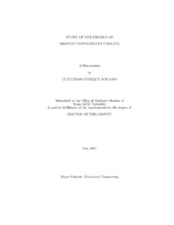| dc.description.abstract | Spray cooling is one of the most promising technologies in applications which
require large heat removal capacity in very small areas. Previous experimental studies
have suggested that one of the main mechanisms of heat removal in spray cooling is
forced convection with strong mixing due to droplet impingement. These mechanisms
have not been completely understood mainly due to the large number of physical variables,
and the inability to modulate and control variables such as droplet frequency
and droplet size. Our approach consists of minimizing the number of experimental
variables by controlling variables such as droplet direction, velocity and diameter.
A study of heat transfer for single and multiple droplet impingements using HFE-
7100 as the cooling fluid under constant heat flux conditions is presented. Monosized
single and multiple droplet trains were produced using a piezoelectric droplet generator
with the ability to adjust droplet frequency, diameter, velocity, and spacing
between adjacent droplets. In this study, heaters consisting of a layer of Indium Tin
Oxide (ITO) as heating element, and ZnSe substrates were used. Surface temperature
at the liquid-solid interface was measured using Infrared Thermography. Heat
transfer behavior was characterized and critical heat flux was measured. Film thickness
was measured using a non-invasive optical technique inside the crown formation produced by the impinging droplets. Hydrodynamic phenomena at the droplet impact
zone was studied using high speed imaging. Impact regimes of the impinging
droplets were identified, and their effect on heat transfer performance were discussed.
The results and effects of droplet frequency, droplet diameter, droplet velocity, and
fluid flow rate on heat flux behavior, critical heat flux, and film morphology were
elucidated.
The study showed that forced heat convection is the main heat transfer mechanism
inside the crown formation formed by droplet impingement and impact regimes
play an important role on heat transfer behavior. In addition, this study found that
spacing among adjacent droplets is the most important factor for multiple droplet
stream heat transfer behavior. The knowledge generated through the study provides
tools and know-how necessary for the design and development of enhanced spray
cooling systems. | en |


